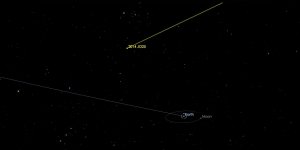| News / Science News |
A Space Spider Watches Over Young Stars
NASA | APRIL 14, 2016
A nebula known as "the Spider" glows fluorescent green in an infrared image from NASA's Spitzer Space Telescope. The Spider, officially named IC 417, lies near a much smaller object called NGC 1931. Together, the two are called "The Spider and the Fly" nebulae. Nebulae are clouds of interstellar gas and dust where stars can form.

The Spider Nebula lies about 10,000 light-years away from Earth and is a site of active star formation. ![]()
The Spider, located about 10,000 light-years from Earth in the constellation Auriga, is clearly a site of star formation. It resides in the outer part of the Milky Way, almost exactly in the opposite direction from the galactic center.
One of the largest clusters of young stars in the Spider can be seen easily in the image. Toward the right of center, against the black background of space, you can see a bright group of stars called "Stock 8." The light from this cluster carves out a bowl in the nearby dust clouds, seen in the imageas green fluff. Along the sinuous tail in the center, and to the left, the groupings of red point sources clumped in the green are also young stars.
In the image, infrared wavelengths, which are invisible to the unaided eye, have been assigned visible colors. Light with a wavelength of 1.2 microns, detected by 2MASS, is shown in blue. The Spitzer wavelengths of 3.6 and 4.5 microns are green and red, respectively.
YOU MAY ALSO LIKE





